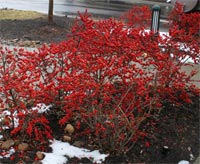This news item expired on Tuesday, December 31, 2013 so the information below could be outdated or incorrect.
Although nearly everyone recognizes our native American holly, and probably other evergreen varieties as well, many gardeners are not familiar with the deciduous hollies. In November, when the plants drop their leaves, exposing masses of bright red  berries, we get a lot of "what is that plant" questions.
berries, we get a lot of "what is that plant" questions.
Deciduous hollies go largely unnoticed and under-used because most of the year they are just ordinary shrubs. But in the right location a deciduous holly may be appreciated during the fall and winter months when the red berries provide a splash of color and, eventually, food for hungry birds.
Both winterberry holly (llex verticillata) and possomhaw (llex deciduas) are native North American plants. Possomhaw varieties are generally small trees and winterberries are shrubs. There are also some excellent hybrids of l. verticillata and l. serrata, a native of Japan.
All of the deciduous hollies will do well with at least a half day of sun and average soils. They are also a good choice for wet sites, even tolerating occasional flooding. The most popular variety of l. verticillata is "Winter Red".
The best known l. deciduas is probably "Warren Red". Some good hybrids include "Sparkleberry", "Bonfire", and "Carolina Cardinal".
Like most hollies, male flowers and female flowers are borne on separate plants; therefore, a male plant should also be planted to assure good berry production on the female plants. You only need a single male plant. It can be off to the side some place, but should probably be in sight for the bees to effectively carry the pollen to the females. For maximum effect, locate the female plants in front of a wall or an evergreen hedge to really show off
the bright berries.
For more information, call Buncombe County Cooperative Extension at 255-5522.